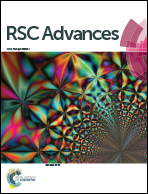Pretreatment of coir lignocellulose for preparation of a porous coir–polyurethane composite with high oil adsorption capacity
Abstract
In this present work, different treatment methods of coir biomass were investigated to improve the oil sorption capacity. The treated coir material was then used to fabricate an efficient porous coir–polyurethane composite sorbent by incorporating coir into a polyurethane matrix. The new composite possessed an open cell structure with high porosity and high oil sorption efficiency. The suitable technical parameters of the coir treatment process were selected as: hot water treatment at 170 °C for 120 minutes. After treatment under this suitable condition, treated coconut fiber exhibited an oil adsorption capacity of 4.1 g g−1, with an increase of 78.3% compared to that of the original coconut fiber. Furthermore, the application of the as-fabricated porous composite sorbent for oil treatment was examined under various conditions. It was observed that the oil uptake capacity of the new composite sorbent was high, up to 15.2 g g−1 when 20% treated coir material with a particle size of 1 mm was added into the polyurethane matrix. Several advantages of the new porous composite sorbent obtained from coir biomass and polyurethane such as low cost, being eco-friendly, ready availability and high buoyancy make it an efficient sorbent material for oil spill treatment.



 Please wait while we load your content...
Please wait while we load your content...